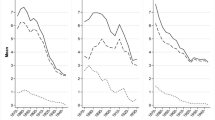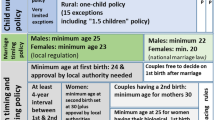Abstract
Fertility in nineteenth century Europe before the fertility transition has been described as high, unregulated, and stable; the extent of fertility control remains a controversial topic. The aim of this study is to determine whether there is evidence of deliberate birth spacing in northern Sweden prior to the onset of the fertility transition. This study analyses micro-level parish records of 9,636 women in nineteenth century northern Sweden—a remote but, at the time, economically dynamic frontier region of Sweden. Event history analysis reveals evidence of birth spacing that suggests some conscious birth control. Piecewise exponential models of the transition from second to third birth reveal circumstances in which parents increased or decreased the time to next birth. The results on the survival of previous children, geographic context, sex of previous children, and variations in grain prices all indicate that parents deliberately manipulated the spacing between births.
Résumé
Si la fécondité prétransitionnelle en Europe au 19e siècle a été décrite comme élevée, stable et non régulée, l’existence d’un certain contrôle de la fécondité reste un sujet controversé. L’objectif de cet article est de déterminer l’éventuelle existence d’un espacement volontaire des naissances dans le Nord de la Suède avant le début de la transition de fécondité. Les données proviennent des registres paroissiaux et concernent 9 636 femmes du Nord de la Suède au 19e siècle, dans une région éloignée mais frontalière caractérisée par un grand dynamisme économique à cette époque. L’analyse biographique révèle un espacement des naissances qui suggère un certain contrôle volontaire des naissances. Des modèles exponentiels par morceaux de la transition entre la deuxième et la troisième naissance révèlent des situations au cours desquelles les parents allongent ou raccourcissent l’intervalle entre naissances. Les résultats basés sur la survie de l’enfant précédent, le contexte géographique, la composition par sexe de la fratrie déjà constituée et les fluctuations du prix des céréales, indiquent que les parents contrôlaient volontairement l’intervalle intergénésique.



Similar content being viewed by others
Notes
The reference level often used for a maximum practical fertility in a population is that of the American Hutterites in the 1920s. The Hutterites are an example of a group with completely unregulated marital fertility in a strongly pro-natalist society.
The main exception being France and possibly a few smaller populations like the Jews and the European aristocracy (Livi-Bacci 1986).
Less than 5% of two-child mothers are censored because of high age.
Bongaarts et al. (1984) provides a complete model of all proximate determinants of fertility.
Information is available from 1820 in all parishes; the registers are discontinued at different years between 1894 and 1900.
Parishes in the region are Gällivare, Jukkasjärvi, and Karesuando.
Parishes in the region are Skellefteå landsförsamling, Jörn and Norsjö.
Parishes in the region are Indal, Sättna, Sundsvalls stad, and Tuna.
The measure of a successful conception is a recorded birth subtracting 9 months.
Not a single divorce is reported for any of the mothers during the study period.
93% of both second births and third births are within marriage.
See Zhao (1997) for how patterns in parity progression according to gender and number of children are used as an indicator of birth control in pre-transitional China.
References
Alm Stenflo, G. (1994). Demographic description of the Skellefteå and Sundsvall regions during the 19th century. Umeå: Umeå University.
Anderson, M. (1988). Population change in north-western Europe, 1750–1850. Basingstoke, UK: Macmillan Education.
Anderton, D. L., & Bean, L. L. (1985). Birth spacing and fertility limitation: A behavioral analysis of a nineteenth century frontier population. Demography, 22(2), 169–183.
Bengtsson, T. (1986). Comparison of population trends and cycles in England, France and Sweden. In Meddelanden från Ekonomisk-historiska Institutionen No. 45. Lund: Lund University.
Bengtsson, T., & Ohlsson R. (1988). Seasonality in births and economic cycles: Sweden 1749–1869. In Meddelanden från Ekonomisk-historiska Institutionen No. 56. Lund: Lund University.
Bengtsson, T., & Dribe, M. (2005). New evidence on the standard of living in Sweden during the 18th and 19th centuries: Long‐term development of the demographic response to short‐term economic stress. In R. C. Allen, T. Bengtsson, & M. Dribe (Eds.), Living standards in the past. New perspectives on well‐being in Asia and Europe (pp. 342–372). Oxford, UK: Oxford University Press.
Bengtsson, T., & Dribe, M. (2006). Deliberate control in a natural fertility population: Southern Sweden, 1766–1864. Demography, 43(4), 727–746.
Bongaarts, J., Odile, F., & Lesthaeghe, R. (1984). The proximate determinants of fertility in Sub-Saharan Africa. Population and Development Review, 10(3), 511–537.
Carlsson, G. (1966). The decline of fertility: Innovation or adjustment process. Population Studies, 20(2), 149–174.
Chesnais, J. C. (1992). The demographic transition stages, patterns, and economic implications (A longitudinal study of sixty-seven countries. Covering the period 1720–1984). Oxford, UK: Clarendon Press.
Coale, A. J. (1986). The decline of fertility in Europe since the eighteenth century as a chapter in demographic history. In A. J. Coale & S. C. Watkins (Eds.), The decline of fertility in Europe (pp. 1–30). Princeton, NJ: Princeton University Press.
Coale, A. J., & Treadway, R. (1986). Appendix B. In A. J. Coale & S. C. Watkins (Eds.), The decline of fertility in Europe (pp. 153–162). Princeton, NJ: Princeton University Press.
Coale, A. J., & Trussell, J. T. (1974). Model fertility schedules: Variations in the age structure of childbearing in human populations. Population Index, 40(2), 185–258.
Coale, A. J., & Zelnik, M. (1963). New estimates of fertility and population in the United States. Princeton, NJ: Princeton University Press.
Dribe, M. (2003). Liv och rörelse: Familj och flyttningar i 1800-talets svenska bondesamhälle. Hedemora: Gidlunds förlag.
Dribe, M., & Scalone, F. (2010). Detecting deliberate fertility control in pre‐transitional populations: Evidence from six German villages, 1766–1863. European Journal of Population, 26(4), 411–434.
Edvinsson, S. (2000). The Demographic Data Base at Umeå University—a resource for historical studies. In P. H. Hall, R. McCaa, & G. Thorvaldsen (Eds.), Handbook of international historical microdata for population research (pp. 259–284). Minneapolis: Minnesota Population Center.
Gaunt, D. (1973). family planning and the pre-industrial society: Some Swedish Evidence. In K. Ågren, et al. (Eds.), Aristocrats, farmers and proletarians. Essays in Swedish demographic history (pp. 28–59). Uppsala: Esselte.
Grummer-Strawn, L. M., Stupp, P. W., & Mei, Z. (1998). Effect of a child’s death on birth spacing: A cross-national analysis. In M. R. Montgomery & B. Cohen (Eds.), From death to birth: Mortality decline and reproductive change (pp. 39–73). Washington, DC: National Academy Press.
Guinnane, T. W., Okun, B. S., & Trussell, J. (1994). What do we know about the timing of fertility transitions in Europe? Demography, 31(1), 1–20.
Hammel, E. A., & Galloway, P. R. (2000). Structural and behavioural changes in the short-term preventive check in the Northwest Balkans in the 18th and 19th centuries. European Journal of Population, 16(1), 67–108.
Henry, L. (1953[1972]). Theoretical basis of measures of natural fertility (transl. Fondements théoriques des mesures de la fécondité naturelle. Revue de l’Institut International de Statistique, 21(3), 135–151). In L. Henry, On the measurement of human fertilty (pp. 1–26). Amsterdam: Elsevier.
Henry, L. (1961). Some data on natural fertility. Eugenics Quarterly, 8(2), 81–91.
Hoem, J. M. (1993). Classical demographic methods of analysis and modern event-history techniques. In IUSSP: 22nd International population conference, Montreal, Canada, vol. 3, pp. 281–291.
Hoem, J. M., & Linnemann, P. (1988). The tails in moving average graduation. Scandinavian Actuarial Journal, 4, 193–229.
Hofsten, E. (1986). Svensk befolkningshistoria: Några grunddrag i utvecklingen från 1750. Stockholm: Raben & Sjögren.
Jörberg, L. (1972). A history of prices in Sweden 1732–1914. Sources, methods, tables, vol. 1. Lund: CWK Gleerup.
Kling, S. (2006). Vi våga ej helt leva: Barnbegränsning, sexualitet och genus under den svenska fertilitetstransitionen. Umeå: Umeå University.
Knodel, J. (1977). Family limitation and the fertility transition: Evidence from the age patterns of fertility in Europe and Asia. Population Studies, 31(2), 219–249.
Knodel, J. (1978). Natural fertility in pre-industrial Germany. Population Studies, 32(3), 481–510.
Knodel, J., & van de Walle, E. (1986). Lessons from the past: Policy implications of historical fertility studies. In A. J. Coale & S. C. Watkins (Eds.), The decline of fertility in Europe (pp. 390–419). Princeton, NJ: Princeton University Press.
Larsson, M. (1984). Fruktsamhetsmönster, produktionsstruktur och sekularisering–en jämförelse mellan 69 härader vid 1800-talets slut. Stockholm: Stockholm University.
Lee, R. (1997). Population dynamics: Equilibrium, disequilibrium, and consequences of fluctuations. In: M. Rosenzweig, & O. Stark (eds.), Handbook of population and family economics (vol. 1, pp. 1063–1115).
Lindstrom, D., & Kiros, G. (2007). The impact of infant and child death on subsequent fertility in Ethiopia. Population Research and Policy Review, 26(1), 31–49.
Lithell, U. (1981). Breast-feeding and reproduction: Studies in marital fertility and infant mortality in 19th century Finland and Sweden. Uppsala: Almqvist & Wiksell International.
Livi-Bacci, M. (1986). Social-group forerunners of fertility control in Europe. In A. J. Coale & S. C. Watkins (Eds.), The decline of fertility in Europe (pp. 182–200). Princeton, NJ: Princeton University Press.
Lockridge, K. (1984). The fertility transition in Sweden. In Demographic Data Base report no. 3. Umeå: Umeå University.
Lynch, K. A., & Greenhouse, J. B. (1994). Risk factors for infant mortality in nineteenth-century Sweden. Population Studies, 48(1), 117–133.
Park, C. B., Ataharul, M., Chakraborty, N., & Kantner, A. (1998). Partitioning the effect of infant and child death on subsequent fertility: An exploration in Bangladesh. Population Studies, 52(3), 345–356.
Rogers, J. (1995). Social differentials and fertility decline in Uppsala and Västerås. In A. Brändström & L. Tedebrand (Eds.), Report from the Demographic Data Base no. 10 (pp. 175–218). Umeå: Umeå University.
Santow, G. (1995). Coitus interruptus and the control of natural fertility. Population Studies, 49(1), 19–43.
Schultz, T. (1985). Changing world prices, women’s wages and the fertility transition: Sweden, 1860–1910. Journal of Political Economy, 93(6), 1126–1154.
Statistics Sweden. (1999). Befolkningsutvecklingen under 250 år: Historisk statistik för Sverige. Demografiska Rapporter, 1999, 2.
Tsuya, N. O., Feng, W., Alter, G., Lee, J. Z., et al. (2010). Prudence and pressure. Reproduction and human agency in Europe and Asia, 1700–1900. Cambridge, MA: MIT Press.
Umea University (2009). Kyrkböcker – församlingsinformation och registreringsperioder. Demographic Data Base, Umeå University. http://www.ddb.umu.se/digitalAssets/49/49482_registreringsperioder.pdf. Accessed 1 Nov 2010.
Van Bavel, J. (2003). Birth spacing as a family strategy: Evidence from 19th century Leuven, Belgium. The History of the Family, 8(4), 585–604.
Van Bavel, J. (2004a). Deliberate birth spacing before the fertility transition in Europe. Population Studies, 58(1), 95–107.
Van Bavel, J. (2004b). Detecting stopping and spacing behaviour in historical demography. Population, 59(1), 117–128.
Van Bavel, J., & Kok, J. (2004). Birth SPacing in the Netherlands. The effects of family composition, occupation and religion on birth intervals, 1820–1885. European Journal of Population, 20(2), 119–140.
Wilson, C. (1984). Natural fertility in pre-industrial England, 1600–1799. Population Studies, 38(2), 225–240.
Wilson, C., Oeppen, J., & Pardoe, M. (1988). What is natural fertility? The modelling of a concept. Population Index, 54(1), 4–20.
Wrigley, E. A. (1966). Family limitation in pre-industrial England. The Economic History Review, 19(1), 82–109.
Zhao, Z. (1997). Deliberate birth control under a high-fertility regime: Reproductive behavior in China before 1970. Population and Development Review, 23(4), 729–767.
Acknowledgments
I am grateful to staff at the Demographic Database in Umeå who have created the excellent data I have used, in particular Sören Edvinsson and Carin Hedlund who were very helpful with suggestions of parishes to use in the initial stages of the study, and for carrying out some of the initial data preparation. I also thank Gunnar Andersson for methodological advice and Elizabeth Thompson for early feedback on theoretical issues. Finally, I thank George Alter for valuable comments on an earlier draft of the paper.
Author information
Authors and Affiliations
Corresponding author
Rights and permissions
About this article
Cite this article
Kolk, M. Deliberate Birth Spacing in Nineteenth Century Northern Sweden. Eur J Population 27, 337–359 (2011). https://doi.org/10.1007/s10680-011-9228-z
Received:
Accepted:
Published:
Issue Date:
DOI: https://doi.org/10.1007/s10680-011-9228-z




